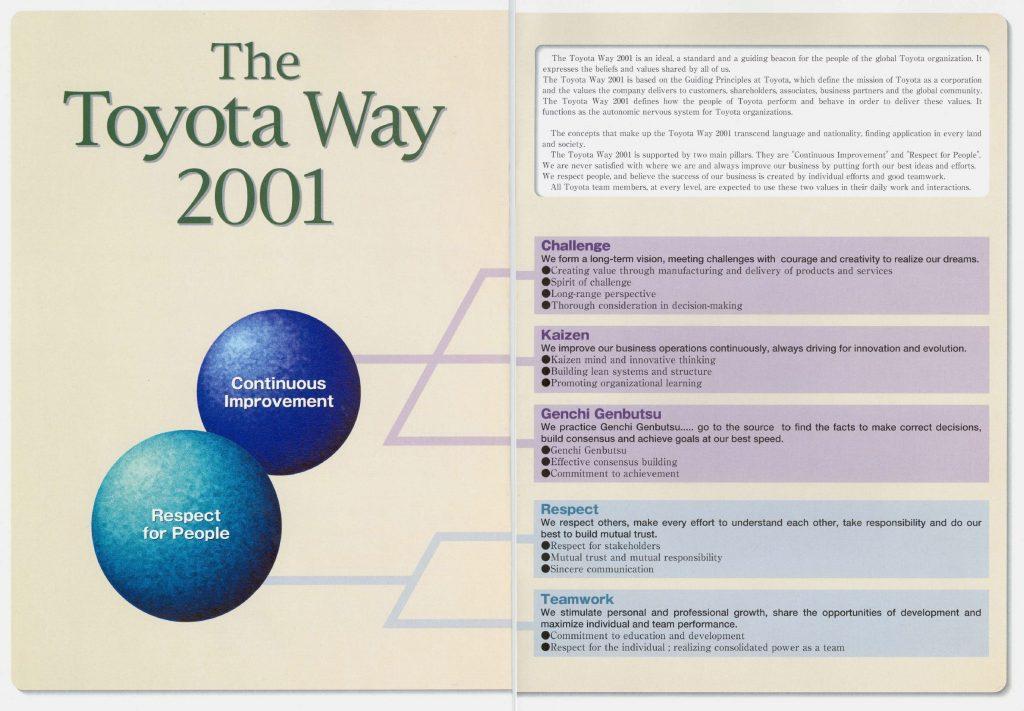
Toyota is widely regarded as the Lean community’s “True North,” the compass guiding us on who we should be and what we should do as a Lean community. Twenty years ago this past April, Toyota Motor Corporation published “The Toyota Way 2001” internal document. The basic ideas contained in the document, shown in the image below, are worth revisiting to see how well the Lean community is doing in relation to this characterization of our “True North” which it embraced more than 15 years ago. Specifically, where do weaknesses exist today and what are our improvement opportunities?
Under the sub-category “Challenge,” the major weaknesses that remains with us today are “Spirit of challenge” and “Thorough consideration in decision-making.” In the former, there is less of a desire to take on challenges and a much stronger desire for acceptance, agreement, and conflict avoidance. This, in turn, substantially reduces the quality and effectiveness of decision-making.
Under the sub-category “Kaizen,” the major weaknesses that remains with us today are “Kaizen mind and innovative thinking” and “Promoting organizational learning.” There is a very poor understanding and practice of the former, kaizen, which results in insufficient innovative thinking. The combination of these two things results in little organizational learning that is useful.
Under the sub-category of “Genchi Genbutsu,” the major weaknesses that remains with us today are “Genchi genbutsu” and “Commitment to achievement.” Yes, people “go and see,” but what really comes of it? Too often people go to the genba and see, but they do not do good enough work when it comes to observation and problem-solving.
Under the sub-category of “Respect,” the major weaknesses that remains with us today are all three items: “Respect for stakeholders” and “Mutual trust and mutual responsibility,” and “Sincere communication.” The meaning of “respect” has become misunderstood and is often used to shut down disagreement. Mutual trust and responsibility suffer because of this, but the larger problem is the avoidance of information that contradicts or upsets one’s views. The lack of engagement on this point closes off sincere communication.
Under the sub-category of “Teamwork,” the major weakness that remains with us today is “Commitment to education and development.” Yes, Lean people avidly educate themselves, but mainly in relation to their biases for Lean management. Most people scrupulously avoid making the effort to understand counterarguments that would lead to their further development.
What I have said here applies to the leaders of our community as well as followers. It’s everyone; you and me.
Last year, Toyota published The Toyota Way 2020, which to my eye is both a simplification and elaboration of some key ideas contained in The Toyota Way 2001 document (click on image below to enlarge or click here to view the Toyota Way 2020 web page).

Here are my thoughts on the top row of panels (left to right). As a Lean community:
- We act more for ourselves than we do for others
- Integrity is lacking in terms of professionalism, standards, and ethics
- Curiosity has been replaced by cognitive biases, particularly confirmation bias
- Observation and other sensory perceptions are not used to their full extent
- Stagnation is more evident than getting better and better every day
And the bottom row of panels. As a Lean community:
- We are more accepting of status-quo than we realize
- We focus more on noise than signal and thus lack new ideas
- We treat colleagues as competitors, as enemies, rather than as those we can learn from and improve
- We shun diverse perspectives and make some people feel unwelcome
- We don’t thank one another for our sincere efforts, working to the best of our abilities to make needed progress
Overall, I would say that we have a long way to go to understand “True North” — who we should be and what we should do. These are our collective improvement opportunities for the next 20 years.
